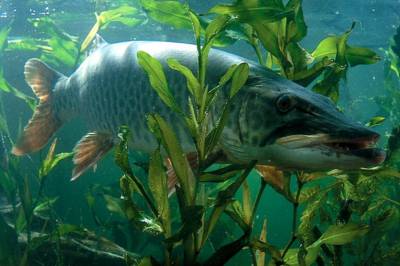


|
Main » Olfaction & Gustation
Freshwater
percid (Percidae) fish can be divided into the two groups depending on type of
their activity and sensory equipment. European perch,
Perca fluviatilis, American yellow
perch, Perca flavescens, and numerous
American darters (Etheostoma)
demonstrate the diurnal type of activity (first of all of the feeding
activity), are visually guided fish and, thus, may be included in the first
group.
In
laboratory and natural conditions, both perches usually do not eat immobile as well as dead
food and demonstrate relatively weak responses to food odors or their absence. According
to Mirza et al. (2003), an aqueous brine shrimp (Artemia spp.) extract (5 g of frozen shrimp in 150 ml of distilled
water for 1 hour) induces searching movements in P. flavescens. Both perches, however, do not go practically into
the minnow traps baited with the animal lures (in contrast to cyprinid, cobitid and other fish).
In
aquarium, blinded P. fluviatilis may find
the pieces of earthworms using olfactory and gustatory systems (Wunder, 1927).
But convergence of perch with brown trout, Salmo
trutta, on sensory system utilization is incorrect.
Both
species of euryhaline
Percarina, Azov percarina, P. maeotica, and common percarina, P. demidoffi, use vision in day when hunting for zooplankton and
lateral line system at night when hunting for preyfish (Kanaeva, 1956).
Roberts and
Winn (1962) have tested utilization of the senses in feeding behavior of johnny
darter, Etheostoma nigrum, using live
worms (Tubifex), dead worms and crushed worm solutions. It is shown that
darters prefer live worms and respond slightly to an olfactory stimulus. Daugherty
et al. (1976) have studied responses of six species of darters (E. gracile, E. spectabile, E. whipplei, E.
radiosum, E. collettei and E.
punctulatum) to visual and olfactory cues of worms. It is revealed that
olfactory cues (water from live Tubifex) alone are not sufficeint to stimulate
complete feeding behaviour in darters, both in clear or muddy waters.
Fountain
darter, Etheostoma fonticola,
respond to live aquatic microinvertebrates and ignore immobile items (Shenck & Whiteside, 1977).
Darters or
longperches of Percina genus are also
diurnally active and feed on live macroinvertebrates (Greenberg, 1991). Percina
are more mobile than Etheostoma and spent most time above the bottom.
Another
group is formed by percids with the twilight or nocturnal type of feeding
activity with the well developed chemosensory and lateral line systems. Three
Europen zander
...
Read more »
|
Microsmatic fish are represented by species in which the well developed
visual system provides most of the behavioural responses in comparison with the
less developed chemosensory system (Devitsina & Malyukina, 1977). Visually
guided diurnal or twilight predators, like Northern pike, Esox lucius, and other Esocidae, on the one hand, and visually
guided planktoneaters, like Black Sea black-striped pipefish,
Syngnathus nigrolineatus, and
other Syngnathidae, on the second hand, form this group of fish (e.g.,
Doroshenko, 2008). In general, the chemosensory system of microsmatic fish
provides first of all their reproductive behaviour, spatial migration,
partially anti-predator behaviour and is weak or indifferent in providing
feeding responses.
Data for microsmatic fish are given by many authors (Hara, 1975; Devitsina, 1977; Devitsina & Malyukina, 1977; Doroshenko, 1981, 2008).
Pike & Musky
According to data received by Devitsyna & Malyukina (1977) in the electrophysiological experiments, the olfactory system of pike, E. lucius, responds
only to conspecific sexual pheromones (gonad extracts), but does not respond to conspecific odors, pure water and feeding substances like fish blood or tissue extracts. In the behavioural
experiments with pike, Nilsson & Brönmark (1999) have found that the
chemical cues from the foraging conspecifics render only minor effects upon
the foraging individuals. In the behavioural
experiments with pike, Nilsson & Brönmark (1999) have found that the
chemical cues from the foraging conspecifics render only minor effects upon
the foraging individuals.
In feeding behaviour, musky, E. masquinongy, use mainly vision and lateral sensory systems (New et al., 2001).
Pike larvae decrease the frequency of their attacks
on zooplankters and show other anti-predator responses to chemical cues of Eurasian
perch, Perca fluviatilis (Lehtiniemi,
2005; Lehtiniemi et al., 2005). Chemical cues of perch (water
from under adult predators, 15
cm length, fed on pike larvae until experiments) affect alone,
but chemical and visual cues offered together are more effective. Furthermore, it is shown that pike are attracted by alarm
pheromone of fathead minnow, Pimephales
promelas (Mathis et al., 1995; Chivers et al., 1996; indirect data by Wisenden
& Thiel, 2001). In addition, pike demonstrate distinct foraging responses
to artificial hypoxanthin-3(N)-oxide (Mathis et al., 1995) identified as an
active component of ostariophysan fish alarm pheromones.
...
Read more »
| |
|
CALENDAR |
|---|
| « June 2025 » |
| Su |
Mo |
Tu |
We |
Th |
Fr |
Sa |
| 1 | 2 | 3 | 4 | 5 | 6 | 7 | | 8 | 9 | 10 | 11 | 12 | 13 | 14 | | 15 | 16 | 17 | 18 | 19 | 20 | 21 | | 22 | 23 | 24 | 25 | 26 | 27 | 28 | | 29 | 30 | |

|




